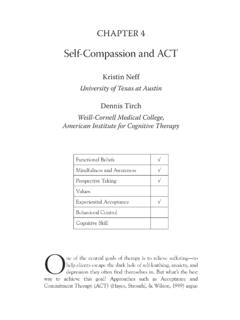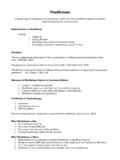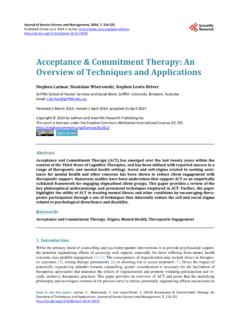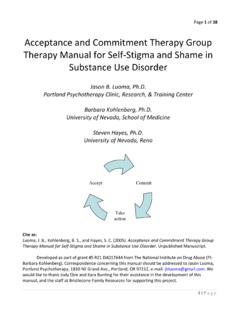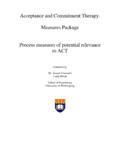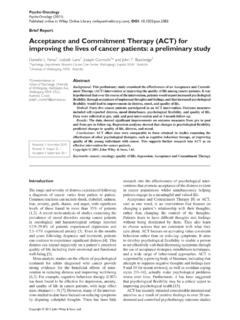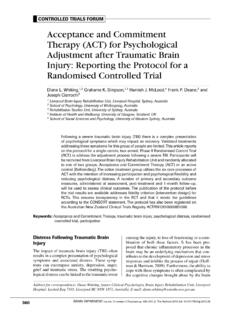Transcription of Acceptance and Commitment Therapy - PLEA
1 233 Chap ter 11 Acceptance and Commitment TherapyLisa W. Coyne, Kirstin B. Birtwell, Louise McHugh, and Kelly WilsonThird-wave cognitive and behavior therapies (Hayes, Villatte, Levin, & Hildebrandt, 2011) involve a transdiagnostic approach concerned not with the elimination of syndromes but rather with building broad, flexible behavioral repertoires (Ruiz, 2010). Acceptance and Commitment Therapy (ACT; Hayes, Strosahl, & Wilson, 1999, 2012) is a prominent example of a transdiagnostic therapeutic approach. Rather than focusing on symptom reduction, ACT encourages Acceptance of aversive private experiences so that one can pursue meaningful and valued activities.
2 ACT has received substantial empirical support across numerous disorder categories (Ruiz, 2010; st, 2008).ACT is grounded in basic behavioral science, more specifically, behavior analysis ( , Cooper, Heron, & Heward, 2007) and relational frame theory (RFT; Hayes, Barnes- Holmes, & Roche, 2001). This ground-ing not only ensures that ACT is coherent and evidence based but also allows for the continued refinement of Therapy at the process level, thus facilitating its ongoing evolution and development. In this chapter, we describe ACT and its evidence base with adults and youth, its underlying philosophy and theoretical model, its conceptualization of experiential avoidance as a transdiagnostic process characterizing psychopathology, and its application as a transdiagnostic Efficacy across DisordersThe ACT approach to psychological dysfunction has been shown to be effective across a wide range of clinical and subclinical presentations.
3 2337/22/2013 2:18:01 PM234 TRANSDIAGNOSTIC CONCEPTUALIZATIONS OF TRADITIONAL THERAPIES Effect sizes have been found to be medium to large and have further improved at follow- up (Ruiz, 2010). In fact, the Substance Abuse and Mental Health Services Administration (SAMHSA) of the govern-ment has recently listed ACT as an empirically supported method as part of its National Registry of Evidence- Based Programs and Practices ( Department of Health & Human Services, 2011). ACT is also considered an empirically validated treatment by the American Psychological Asso-ciation and is recognized as having moderate to strong research support for chronic pain, obsessive compulsive disorder (OCD), mixed anxiety depression, and psychosis ( ).
4 In addition to the areas cited, ACT trials with adult samples using single- case, open-trial, and randomized- trial methodology have demon-strated positive outcomes for individuals with the following presenta-tions: personality disorders ( , borderline personality disorder), sub-stance abuse, smoking cessation, diabetes management, epilepsy, cancer, and weight loss (for comprehensive reviews, see Hayes, Luoma, Bond, Masuda, & Lillis, 2006; Ruiz, 2010). At present, more than 50 random-ized clinical trials (RCTs) of ACT have been published, are in press, or are in preparation (see Table ). Although promising results have surfaced thus far, replication and further research in new domains are needed especially with the breadth and depth of empirical investigation with adults, studies exploring ACT-based treatment adaptations for children, adoles-cents, and families have been limited in both quantity and scope ( , small sample size, single- case or uncontrolled studies, lack of interstudy consistency).
5 Nonetheless, researchers are analyzing ACT-based protocols for children and adolescents suffering from various mental health disor-ders, chronic pain, eating disorders, and sickle cell disease. In addition, two published studies have evaluated ACT for parent populations, and several other trials are under the field is only in its infancy, child- and adolescent- targeted ACT trials have demonstrated largely favorable outcomes for a range of mental health challenges. For example, Hayes, Boyd, and Sewell (2011) recently published results from an RCT with depressed adolescents, com-paring ACT with a treatment- as-usual (TAU) condition. Participants in the ACT condition reported significantly lower depression levels than those in the TAU group and evidenced further improvement from post-treatment to 3-month follow- up.
6 In addition, Morris and Greco (2002) implemented an ACT-based protocol with socially anxious youngsters and reported a reduction of social anxiety and increased school attendance. In nonclinical populations, ACT resulted in less experiential avoidance, more social confidence, parent- reported shorter episodes of anxiety, and return to school for an 18-year-old developmentally delayed female 2347/22/2013 2:18:01 PM 235 ta BLE StudyProblem/diagnosisNMain findingsZettle & Hayes (1986)Depression 18 ACT is more effective than & Rains (1989)Depression 31 ACT is as effective as CT and CT + & Bunce (2000)Worksite stress and anxiety 90 ACT is more effective than behavioral approach and both are better than wait-list & Hayes (2002)Psychotic inpatients 80 ACT reduces rehospitalization over a 4-month follow-up as compared with (2003)Math anxiety 24 ACT is comparable to systematic desensitization in reducing math anxiety, but systematic desensitization reduces trait anxiety more than , Wilson, & Nilsson (2004)
7 Stress and pain symptoms 19 ACT is more effective than et al. (2004)Smoking cessation 76 Quit rates are similar at posttreatment but 1-year follow-up shows that the ACT group maintains gains while the NRT quit rates , Bissett, et al. (2004)Stigmatizing attitudes and burnout in substance abuse counselors 93 ACT is more effective than , Wilson, et al. (2004)Polysubstance abuse114 ; met hadone maintenance (n = 38), addition of ACT (n = 42), or intensive twelve-step facilitation (ITSF; n = 44)No differences at posttreatment, but ACT is more effective at 6-month follow-up.(continued) 2357/22/2013 2:18:01 PM 236 ta BLE (continued)StudyProblem/diagnosisNMain findingsGaudiano & Herbert (2006)Inpatients with psychotic symptoms 40 ACT is more effective than & Gunderson (2006)Borderline personality disorder 22 ACT/DBT combo is more effective than , Dahl, Melin, & Kees (2006)Drug refractory epilepsy 27 ACT reduces seizures significantly more than supportive , Wetterneck, & Flessner (2006)Trichotillomania 25 ACT plus habit reversal is more effective than wait-list , Herbert, Moitra, Yeomans, & Geller (2007)Anxiety and depression101 Participants improve similarly with ACT and , Callaghan, Hayes, & Glenn-Lawson (2007)
8 Diabetes 81 ACT + patient education is more effective than patient et al. (2007)Outpatient 14 ACT is more effective than CBT at posttreatment and 6-month et al. (2007)Psychological disorder stigma 96 ACT reduces mental health stigma significantly, but education reduces stigma among participants who are relatively flexible and nonavoidant to begin ez, Luciano, & Guti rrez (2007)Women diagnosed and treated for breast cancer 12 ACT is more effective than CBT at 1- year et al. (2007)Chronic pain 74 Acceptance group improves more than pain control and practice , Dahl, Yardi, & Melin (2008)Epilepsy patients with drug-refractory seizures 18 ACT reduces seizures more than yoga, but both improve 2367/22/2013 2:18:01 PM 237 Luoma et al.
9 (2008)Drug counselors 30 ACT-based supervision group following training in group drug counseling increase adoption in drug and alcohol , Orsillo, & Salters-Pedneault (2008)Generalized anxiety disorder 31 ACT-based protocol (ABBT) produces positive outcomesVarra, Hayes, Roget, & Fisher (2008)Clinicians 59 ACT is more effective than psychoeducation alone (d = .85)Wicksell, Ahlqvist, Bring, Melin, & Olsson (2008)Chronic pain and whiplash associated disorders (WAD) 21 ACT is more effective than , Hayes, Bunting, & Masuda (2009)Obesity 84 ACT reduces stigma, increases QOL, and reduceds & Zettle (2009)Comorbid depression and alcohol 24 ACT and TAU produce similar outcomes, but ACT uses less et al. (2009)Obesity 62 ACT group has drop in BMI (compared with wait-list controls).
10 Wicksell, Melin, Lekander, & Olsson (2009)Pediatric pain 32 ACT performs significantly better than multidisciplinary treatment plus amitriptyline (MDT).Flaxman & Bond (2010)Worksite stress107 ACT and SIT (stress inoculation training) are equally effective; ACT is mediated by psychological flexibility; SIT is not successfully mediated by cognitive & Bond (2010)Worksite stress311 ACT is better than wait-list , Bohlmeijer, Smit, & Westerhof (2010)Mild to moderate psychological distress 93 ACT shows good outcomes compared with wait-list control.(continued) 2377/22/2013 2:18:01 PM 238 ta BLE (continued)StudyProblem/diagnosisNMain findingsHinton & Gaynor (2010)Psychological distress, dysphoria, and low self-esteem 22 Group receiving ACT component (cognitive defusion) demonstrates better outcomes than wait-list , Foster, Shennan, Starkey, & Johnson (2010)Chronic pain 14 ACT is helpful for chronic , Forman, & Herbert (2010)Comorbid eating pathology 55 ACT produces greater reductions in eating pathology and greater increases in global functioning than CTSmout et al.
